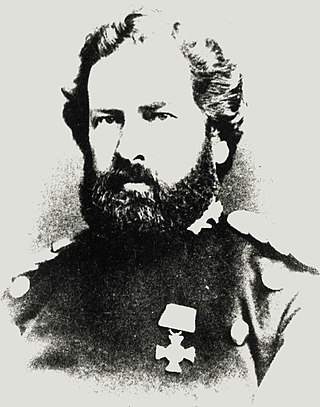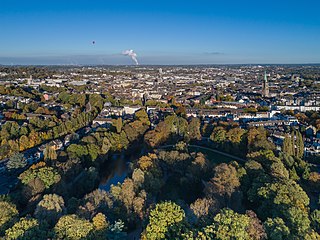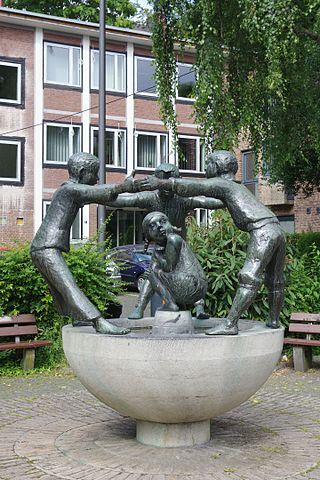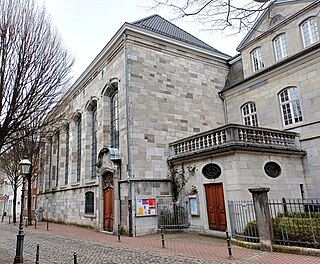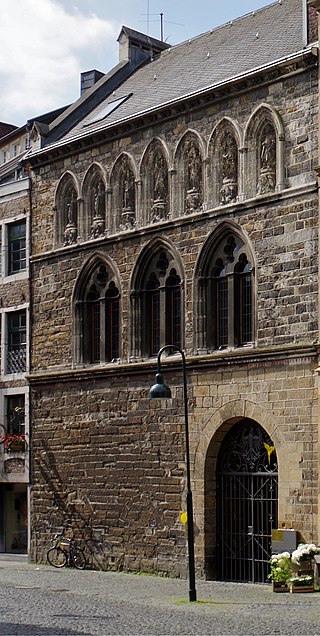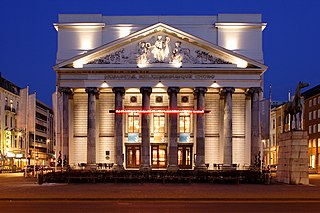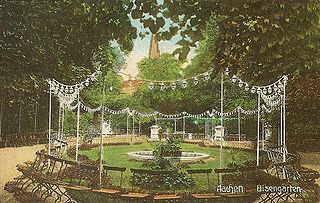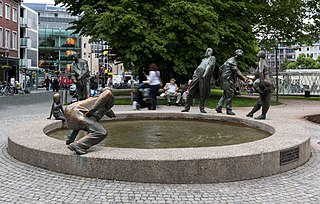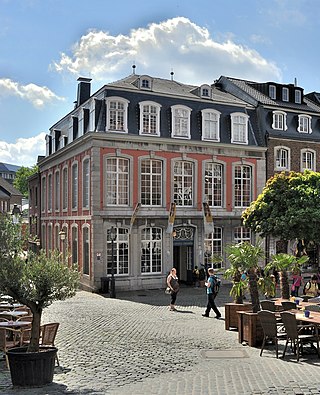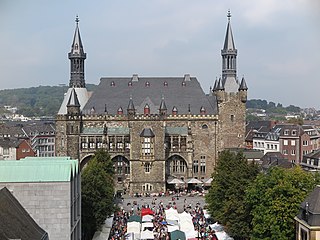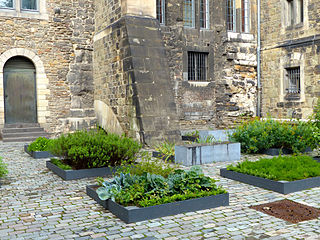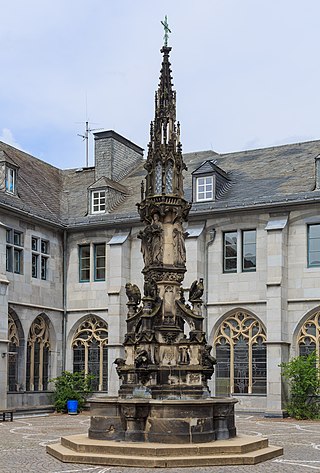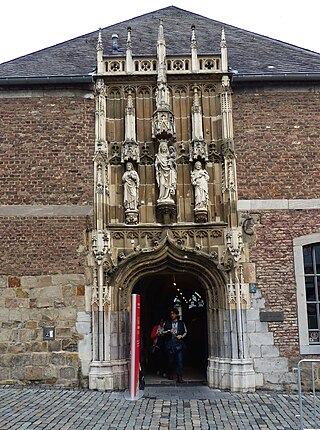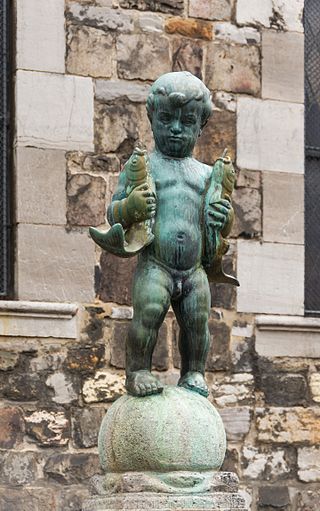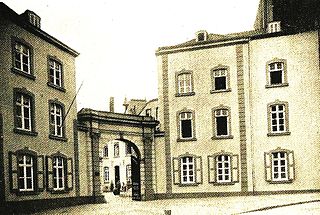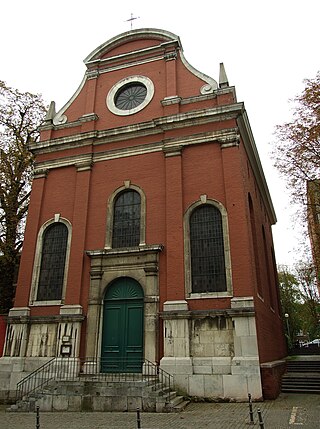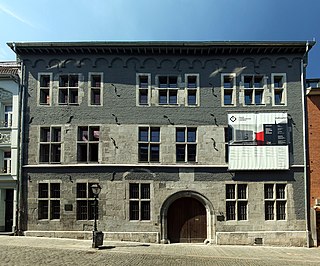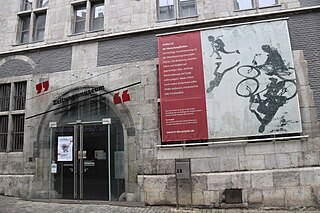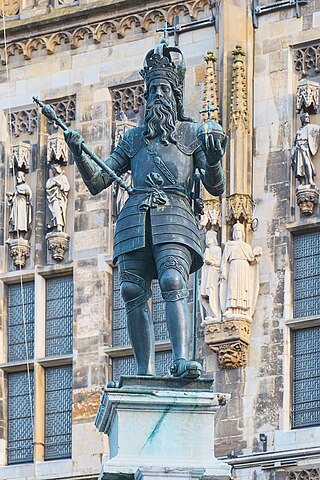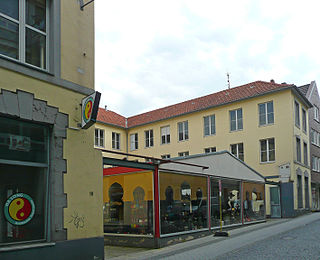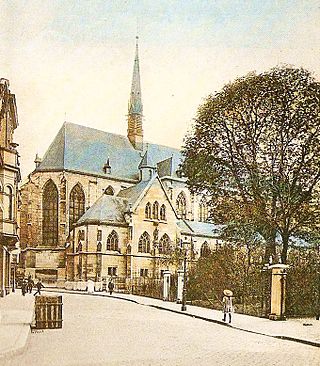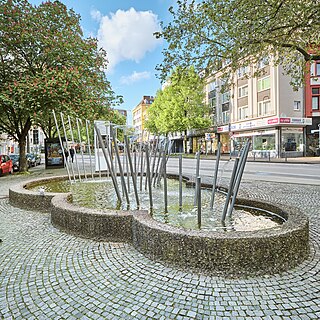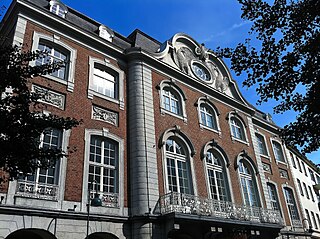Self-guided Sightseeing Tour #2 in Aachen, Germany
Legend
Guided Free Walking Tours
Book free guided walking tours in Aachen.
Guided Sightseeing Tours
Book guided sightseeing tours and activities in Aachen.
Tour Facts
7.8 km
121 m
Experience Aachen in Germany in a whole new way with our free self-guided sightseeing tour. This site not only offers you practical information and insider tips, but also a rich variety of activities and sights you shouldn't miss. Whether you love art and culture, want to explore historical sites or simply want to experience the vibrant atmosphere of a lively city - you'll find everything you need for your personal adventure here.
Activities in AachenIndividual Sights in AachenSight 1: Lochner-Tor
Emil Lochner was an Aachen cloth manufacturer and made a significant contribution to the cityscape of Aachen. Lochnerstraße in Aachen is named after his father.
Sight 2: Westpark
The Westpark is a park in the west of Aachen, which is bounded by Gartenstraße, Welkenrather Straße and Vaalser Straße.
Sight 3: Barockfabrik
The Barockfabrik is a cultural centre under the municipal sponsorship of the city of Aachen. The state-approved vocational school for: acting • directing • musical, Aachen Theatre School, the Öcher Schängchen City Puppet Theatre, the dance workshop Art bewegt and Café Couleur are located here.
Sight 4: Wylre'sches Haus
The Wylre'sche Haus in Aachen is a listed representative residential building at Jakobstraße 35. It takes its name from the forester, alderman and multiple mayor of the imperial city of Aachen, Johann Bertram von Wylre, who had it built in 1669 after the purchase of several plots of land. Since it was taken over by the Aachen branch of the Hoesch/Heusch family, it has also been referred to in literature and in the vernacular as Haus Heusch or Palais Heusch because of its furnishings.
Sight 5: St. Paul
The Church of St. Paul in Aachen is a former Dominican church and later a Roman Catholic parish church. It was profaned in 2009 and has housed the Diocesan Archive of the Diocese of Aachen since 2018. The outer building, destroyed and rebuilt several times, preserves the character of the Gothic mendicant order church. The interior has been modernly redesigned.
Sight 6: Zum Güldnen Verken
The Marianneninstitut was a maternity ward for poor women who had recently given birth in Aachen and the first of its kind in Prussia. The institute was founded in 1830 by the Aachen gynecologist and obstetrician Vitus Jakob Metz (1792–1866) and recorded more than 40,000 births by the time it closed in 1959. It was named after Princess Marianne of Prussia, the wife of Prince William of Prussia.
Sight 7: Türelüre-Lißje-Brunnen
Türelüre-Lißje, also Turelure-Lieschen or Türelüre-Loetche, is the name of a legendary Aachen figure, to whom a fountain monument by the Aachen sculptor Hubert Löneke, which has stood at the entrance to Klappergasse since 19 November 1967, is dedicated.
Sight 8: Annakirche
The Protestant St. Anne's Church is a former monastery church in Aachen, Germany. Since 1802 it has been a Protestant place of worship.
Sight 9: Grashaus
The building at the fish market in Aachen, known as the Grashaus, is not only one of the oldest houses in the city, but also of historical importance as the first Aachen town hall. It was completed in 1267, but probably stands on even older foundation walls from possibly Carolingian times. The Grashaus owes its name to the grass, a medieval village green where executions as well as folk festivals and supposedly the funerals of the executed took place.
Sight 10: Schwimmhalle Elisabethstraße
The Elisabethhalle is a municipal indoor swimming pool in Aachen, Germany, located at Elisabethstraße 10, not far from Aachen Cathedral. It was built from 1908 to 1911 in Art Nouveau style for a total of 900,000 marks and opened on 17 July 1911. The design came from the Aachen city architect Joseph Laurent. The Elisabethhalle is one of the few surviving indoor swimming pools from the Art Nouveau era that are still in operation today.
Sight 11: Theater Aachen
Theater Aachen is a theatre in Aachen, Germany. It is the principal venue in that city for operas, musical theatre and plays. It is the home of the Sinfonieorchester Aachen. The original project was by Johann Peter Cremer, later altered by Karl Friedrich Schinkel. Construction on the original theatre began in 1822 and it opened on 15 May 1825. A bomb attack on 14 July 1943 destroyed the first theatre, and the current structure was inaugurated on 23 December 1951 with a performance of Richard Wagner's Die Meistersinger von Nürnberg.
Sight 12: Grenzlandtheater Aachen
Grenzlandtheater Aachen is a theater in Aachen, North Rhine-Westphalia, Germany founded by actor Kurt Sieder (1899–1964) in 1950.
Sight 13: Elisenbrunnen
The Elisenbrunnen fountain in Aachen is a classicist building designed by the architects Johann Peter Cremer and Karl Friedrich Schinkel. The construction was carried out by the Aachen private master builder Andreas Hansen. The building was named after the Prussian Crown Princess Elisabeth Ludovika of Bavaria (Elise), the daughter of the Bavarian King Maximilian I, wife of the later Prussian King Frederick William IV. Her bust was made of Carrara marble by Christian Friedrich Tieck in 1828 and placed in the rotunda in 1832.
Sight 14: Elisengarten
The Elisengarten is a small park in the city center of Aachen on the rear side of the Elisenbrunnen. The Elisengarten was laid out between 1852 and 1854 according to plans by the Prussian master gardener Peter Joseph Lenné.
Sight 15: Kreislauf des Geldes
The Cycle of Money is a fountain in Aachen created in 1976 by Karl-Henning Seemann. It is located in Hartmannstraße at the end of the Elisengarten. The fountain, which is financed by the Sparkasse Aachen, is usually called Geldbrunnen in short. In 2007, the fountain figures were renovated.
Sight 16: Vinzenzbrunnen
The Vinzenz Fountain on Aachen's Münsterplatz is a fountain consecrated in 1847, which was created by the Aachen sculptors Wilhelm Josef Wings and Gottfried Götting according to a design by the then Aachen city architect Friedrich Joseph Ark.
Sight 17: Karls- und Hubertuskapelle
Aachen Cathedral is a Catholic church in Aachen, Germany and the cathedral of the Diocese of Aachen.
Sight 18: Puppenbrunnen
The Puppet Fountain is located in Aachen, North Rhine-Westphalia, on Krämerstraße, the connection between the cathedral and the town hall. It was donated by the Aachener Bank and created in 1975 by the Aachen sculptor Bonifatius Stirnberg.
Sight 19: Haus zum Mohren
The Haus zum Mohren is a listed building in Aachen, Germany.
Sight 20: Büchel-Museum Rote Burg
Rote Burg is the name of a historic residential building in Aachen, Germany. It stands on the Büchel and is registered as an architectural monument in the list of monuments of the city of Aachen.
Sight 21: Domkeller
The Domkeller is a listed residential building in Aachen.
Sight 22: Haus zum Lindenbaum
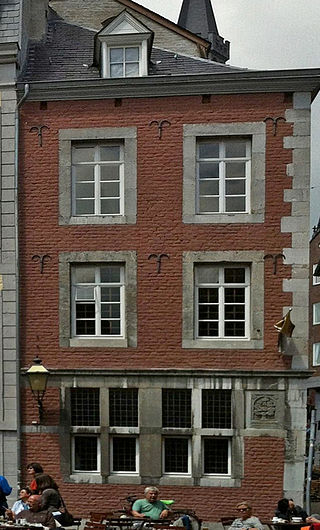
The Haus zum Lindenbaum is a former commercial and residential building in Aachen, Germany. It has been part of the Couven Museum since 1961. The building is a listed building.
Sight 23: Haus Monheim
Haus Monheim is a listed building in the old town of Aachen. It was a residential and commercial building of the Monheim family of pharmacists and is one of the surviving works of Jakob Couven in Aachen. Today it houses the Couven Museum and is registered as an architectural monument in the Aachen list of monuments.
Sight 24: Hühnerdieb
Hühnerdieb is a fountain monument by the Berlin sculptor Hermann Joachim Pagels, which was unveiled at Christmas 1913 at the Aachen Hühnermarkt. It consists of the bronze figure of a chicken thief, which was mounted on a fountain bowl made of shell limestone. The figure shows the moment when the thief is astonished to discover that instead of the chicken, he has stolen a rooster, which crows and thus betrays him. However, the scene embodied in the figure is without historical precedent.
Sight 25: Aachen Town Hall
Aachen Town Hall is a landmark of cultural significance located in the Altstadt of Aachen, Germany. It was built in the Gothic style in the first half of the 14th century.
Sight 26: Karlsgarten
The Karlsgarten at Aachen City Hall is a herb garden with a selection of plants from Charlemagne's Capitulare de villis in Aachen. It was created in 1965. It is located on the south side behind the western tower of Aachen Town Hall at Katschhof. It is one of several Karlsgärten in Germany, France and Austria.
Sight 27: Centre Charlemagne
The Centre Charlemagne – Neues Stadtmuseum Aachen is the local history museum of the city of Aachen. It received its French name after Charlemagne, the best-known and most important historical figure in Aachen; French was chosen instead of German because of the prominent position of the French language in the Eurégion Meuse-Rhin and EU.
Sight 28: Paradiesbrunnen
The Paradise Fountain is a fountain created in 1897 by Georg Frentzen in Aachen in the cloister of Aachen Cathedral.
Sight 29: Domschatzkammer
The Aachen Cathedral Treasury is a museum of the Roman Catholic Diocese of Aachen under the control of the cathedral chapter, which houses one of the most important collections of medieval church artworks in Europe. In 1978, the Aachen Cathedral Treasury, along with Aachen Cathedral, was the first monument on German soil to be entered in the List of UNESCO World Heritage Sites. The treasury contains works from Late Antique, Carolingian, Ottonian, Staufen, and Gothic times. The exhibits are displayed in premises connected to the cathedral cloisters.
Sight 30: Fischpüddelchen
Fischpüddelchen is a fountain monument originally erected in 1911 by Hugo Lederer in front of the baptistery of Aachen Cathedral at the fish market in Aachen. The figure was melted down during the Second World War and recreated in 1954 according to the destroyed model of Heinrich-Clemens Dick. The fountain is a modified copy of the Fischerbuberl fountain by the sculptor Ignatius Taschner, built in 1910 and now standing on Wiener Platz in Munich.
Sight 31: Aula Carolina
The Aula Carolina is a listed building that is available for both school gatherings and public cultural events. It is located at the southern end of Pontstraße in the center of Aachen. The auditorium belonging to the eponymous Kaiser-Karls-Gymnasium is the former church of St. Katharina of the former monastery of the Augustinian hermits.
Sight 32: Torbogen des Klosterather Hofs
The Klosterrather Hof, also known as the Klosterrather Refugium or Kirchrather Hof, was a former monastery courtyard and later a residential and manufacturing complex in the Eilfschornsteinstraße in Aachen.
Sight 33: Theresienkirche
The Theresienkirche is a Catholic city church in Aachen, Germany. It is located in the northeastern area of the city center and borders on the building areas of the RWTH Aachen University. It is owned by the state of North Rhine-Westphalia as a special property.
Sight 34: Großes Haus von Aachen
The Great House of Aachen is one of the oldest surviving residential buildings in the city of Aachen. Its significance as an architectural monument lies in the fact that it survived the Aachen city fire of 1656 largely undamaged. The building now houses the International Newspaper Museum.
Sight 35: International Newspaper Museum
The International Newspaper Museum in Aachen presents the history of newspapers and the topic of press history.
Sight 36: Karlshofbrunnen
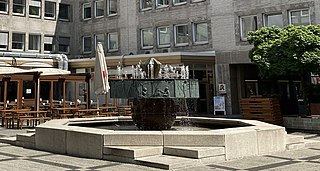
The Karlshof Fountain is located in Aachen, North Rhine-Westphalia in the courtyard of the Karlshof in the immediate vicinity of Aachen's market square.
Sight 37: Haus Löwenstein
The building known as Haus Löwenstein at Markt No. 41, on the corner of Pontstraße in Aachen, was built parallel to Aachen's town hall and completed around 1344. Along with the cathedral and town hall, it is one of the few Gothic buildings that survived the great city fire of 1656.
Sight 38: Karlsbrunnen
The statue of Charlemagne is a prominent public sculpture representing Charlemagne in Aachen. It was first erected in 1620 on the Marktplatz in front of Aachen Town Hall, as part of the monumental Karlsbrunnen fountain. The statue now standing on the Karlsbrunnen is a 1969 copy, and the original has been kept since 2014 at the nearby Centre Charlemagne museum. It has become the most popular image of Charlemagne in the monarch's chosen capital of Aachen.
Sight 39: Londoner Hof
The former London Court was a representative three-winged city villa from the 18th century built by Laurenz Mefferdatis at Kleinkölnstraße 18 in Aachen's city centre, whose actual origins lie in the 15th century. Of the current commercial building standing there, only the ground floor original from the time of Mefferdatis and the approx. 1700 m² floor plan have been preserved, whereupon the building was placed under monument protection in 1977.
Sight 40: St. Nikolaus
The church of St. Nikolaus in Aachen is a former monastery church of the Franciscan order. It stands at the intersection of Großkölnstraße - Minoritenstraße in the immediate vicinity of the Barbarosamauer, the inner city wall of Aachen. A first church there is mentioned in 1005; It was an early church in which Nicholas of Myra was worshiped. Today's church was built in the first half of the 14th century. The building is under monument protection.
Sight 41: Röhrenbrunnen
The Röhrenbrunnen is a fountain in Aachen, Germany. It is located on a triangular square between Komphausbadstraße and Kurhausstraße north of the Old Kurhaus. The fountain was created in 1971 by the sculptor Heinz Tobolla.
Sight 42: Altes Kurhaus
The Old Kurhaus of Aachen was built between 1782 and 1786 according to designs by Jakob Couven at Komphausbadstraße 19 as a Neue Redoute and an extension to the neighboring Alte Redoute Aachen at number 11. In contrast to the Old Kurhaus, the Kurhaus at Monheimsallee 44, which was inaugurated in 1916, is referred to as the Neues Kurhaus Aachen, which also housed the Aachen Casino until 11 June 2015.
Sight 43: ASEAG Kunden-Center
The Aachener Straßenbahn und Energieversorgungs-AG (ASEAG) operates local public transport in the Aachen City Region. Despite its name, it is now a pure bus company. In 2023, it transported approximately 64.209 million passengers on 118 lines in an area of 770 km². This makes it the largest German transport company that relies solely on buses. The length of the line network is 1981.6 km. The ASEAG network is integrated into the Aachener Verkehrsverbund (AVV).
Wikipedia: Aachener Straßenbahn und Energieversorgungs-AG (DE), Website
Share
How likely are you to recommend us?
Disclaimer Please be aware of your surroundings and do not enter private property. We are not liable for any damages that occur during the tours.
GPX-Download For navigation apps and GPS devices you can download the tour as a GPX file.
